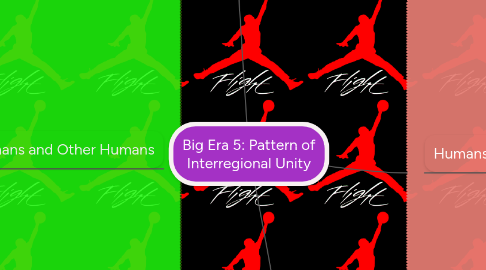
1. Humans and Other Humans
1.1. Pasotral power
1.1.1. Serious challenge to societies
1.2. Western Roman empire collapses
1.2.1. Recovery ensues
1.2.2. Mongols control 7 mil. sq. miles by 1260
1.2.2.1. Arab Muslim controlled 4.3 mil
1.3. Muslim merchants trade many things 7th century
1.4. Commerce
1.4.1. Economic growth
1.4.2. Afroeurasia
1.4.3. Mongols
1.4.4. Black death
1.5. Warfare
1.5.1. New formations
1.5.2. Projectile and gunpowder weapons
1.5.2.1. Cannon and musket
1.5.2.2. Catapults and bows
1.5.3. Naval ships
2. Human and Ideas
2.1. Major belief systems
2.1.1. Christianity
2.1.1.1. Dominant throughout Europe
2.1.2. Buddhism
2.1.2.1. Offered version of immortality
2.1.3. Hinduism
2.1.4. Islam
2.1.4.1. Most dramatic development
2.1.5. Judaism
2.1.5.1. Monotheism
2.2. Scientific and technological traditions
2.2.1. Ideas along land and sea trade routes
2.2.1.1. More intelligence
2.2.1.1.1. More accurate and simple answers
2.2.1.2. New tech
2.2.1.2.1. Quicker production
3. intro
3.1. Population
3.1.1. Agriculture
3.1.1.1. Livestock
3.1.1.2. Irrigation
3.1.2. Trade
3.1.2.1. Variety of food
3.1.2.2. More products
3.1.3. End of Era: 400 mil. people
3.2. Politics
3.2.1. Empires
3.2.1.1. West Africa
3.2.1.2. The Americas
3.2.1.3. Mongols and Arab Muslim
3.2.2. Economics = More complex
3.3. Trade
3.3.1. Indian Ocean Basin
3.3.2. Silk Roads
3.3.2.1. Mongols
3.3.3. Afroeurasia and Americas
3.3.3.1. Art and architecture
3.4. Culture
3.4.1. Belief systems joined
3.4.2. Local religions decline
3.4.3. Universal religions spread
3.4.3.1. Islam
3.4.3.1.1. Widespread Appeal
4. Humans and the Environment
4.1. Trade
4.1.1. New techiniques
4.1.2. New and more trading routes
4.1.3. Better ships
4.2. Population increase
4.2.1. More advanced society
4.2.2. Pop. reached 235 mil. by 1250 CE
4.2.3. Began 6th century
4.2.4. Lasted 700+ years
4.3. Population decline
4.3.1. Infectious disease
4.3.1.1. Justinians plague
4.3.2. Afroeurasia
4.3.3. Climatic change
4.3.3.1. Agricultural decline
4.3.4. Economic recession

